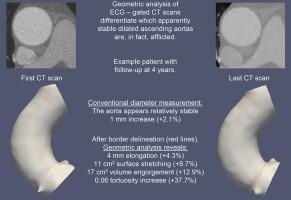Hellenic Journal of Cardiology ( IF 4.1 ) Pub Date : 2023-11-04 , DOI: 10.1016/j.hjc.2023.10.007 Paris Dimitrios Kalogerakos 1 , Athanasios Pirentis 2 , Yiannis Papaharilaou 2 , Christos Skiadas 3 , Apostolos Karantanas 3 , Hamid Mojibian 4 , Maria Marketou 5 , George Kochiadakis 5 , John Alex Elefteriades 6 , George Lazopoulos 7

|
Background
The clinical importance of following-up the ascending aortic diameter lies on the fundamental presumption that wall pathology eventually manifests as change in shape. However, the diameter describes the vessel locally, and the 55mm criterion fails to prevent most dissections. We hypothesized that geometric changes across the ascending aorta are not necessarily imprinted on its diameter; i.e. the maximum diameter correlates weakly and insignificantly with elongation, surface stretching, engorgement, and tortuosity.
Methods
Two databases were interrogated for patients who had undergone at least 2 ECG-gated CT scans. The absence of motion artifacts permitted the generation of exact copies of the ascending aorta which then underwent three-dimensional analysis producing objective and accurate measurements of the centreline length, surface, volume, and tortuosity. The correlations of these global variables with the diameter were explored.
Results
Twenty-two patients, 13 male and 9 females, were included. The mean age at the first and last scan was 63.7 and 67.1y, respectively. The mean diameter increase was approximately 1mm/y. There were no dissections, while 7 patients underwent preemptive surgery. The yearly change rate of the global variables, normalized to height if applicable, showed statistically insignificant, weak or negligible correlation with diameter increments at follow-up. Most characteristically, a patient’s aorta maintained its diameter, while undergoing 1mm/y elongation, 151mm2/(y∙m) stretching, 2366mm3/(y∙m) engorgement, and 0.02/y tortuosity.
Conclusions
Maximum diameter provides a local description for the ascending aorta and cannot fully portray the pathological process across this vessel. Following-up the diameter is not suggestive of length, surface, volume and tortuosity changes.
中文翻译:

尽管随访时直径稳定,升主动脉仍出现显着不利的几何变化。
背景
跟踪升主动脉直径的临床重要性在于壁病理最终表现为形状变化的基本假设。然而,直径描述的是局部血管,55 毫米标准无法防止大多数解剖。我们假设升主动脉的几何变化不一定反映在其直径上;即最大直径与伸长率、表面拉伸、膨胀和弯曲度的相关性较弱且不显着。
方法
对两个数据库进行了询问,以查找至少接受过 2 次心电图门控 CT 扫描的患者。由于没有运动伪影,可以生成升主动脉的精确副本,然后对其进行三维分析,从而客观准确地测量中心线长度、表面、体积和弯曲度。探讨了这些全局变量与直径的相关性。
结果
纳入 22 名患者,其中 13 名男性和 9 名女性。第一次和最后一次扫描的平均年龄分别为 63.7 岁和 67.1 岁。平均直径增加约为 1 毫米/年。没有进行解剖,而 7 名患者接受了先发性手术。全局变量的年变化率(如果适用的话,标准化为高度)显示出与随访时直径增量的统计上不显着、微弱或可忽略不计的相关性。最典型的是,患者的主动脉保持其直径,同时经历 1mm/y 伸长、151mm2/(y∙m) 拉伸、2366mm3/(y∙m) 充血和 0.02/y 弯曲。
结论
最大直径提供了升主动脉的局部描述,但不能完全描绘该血管的病理过程。跟踪直径并不表明长度、表面、体积和弯曲度的变化。



























 京公网安备 11010802027423号
京公网安备 11010802027423号